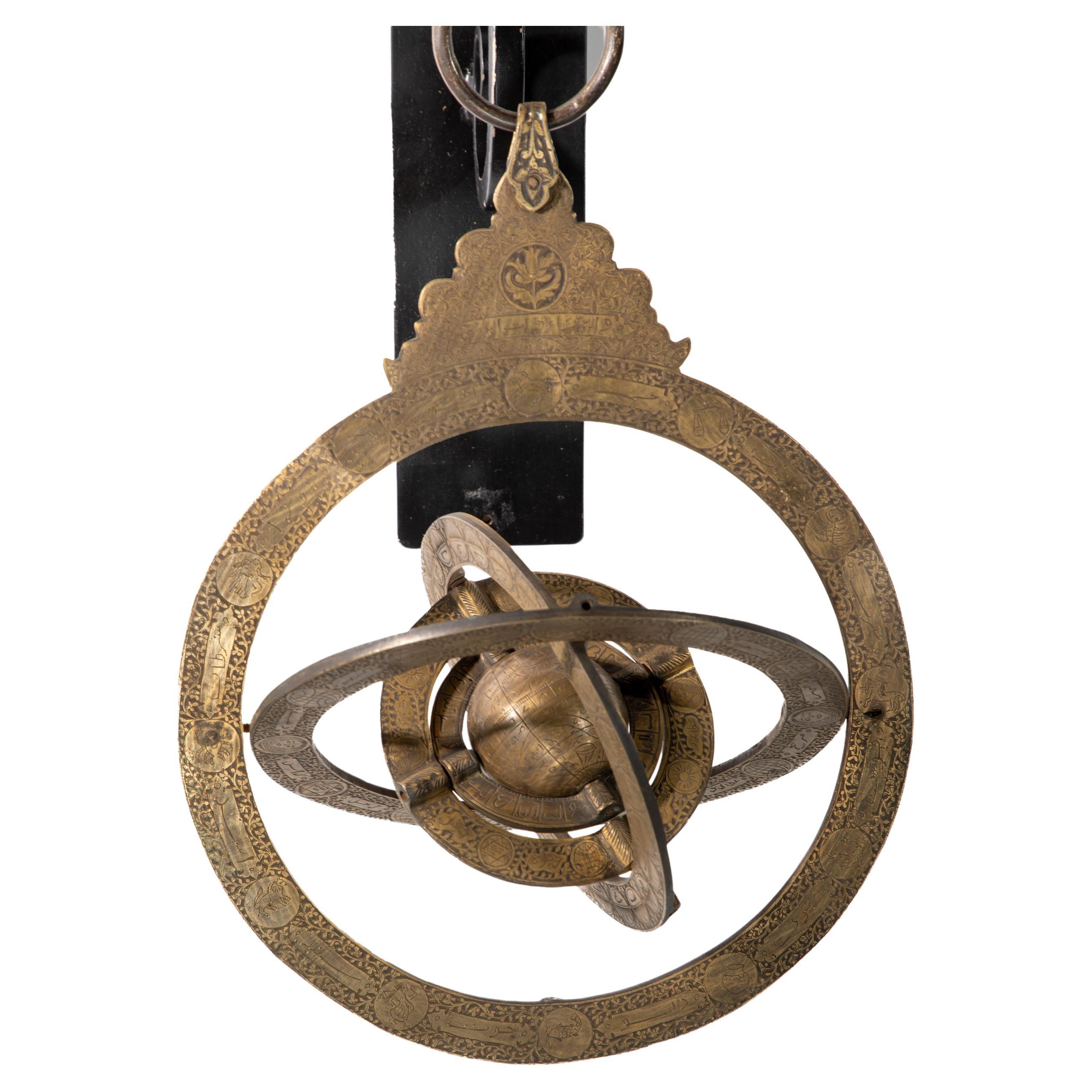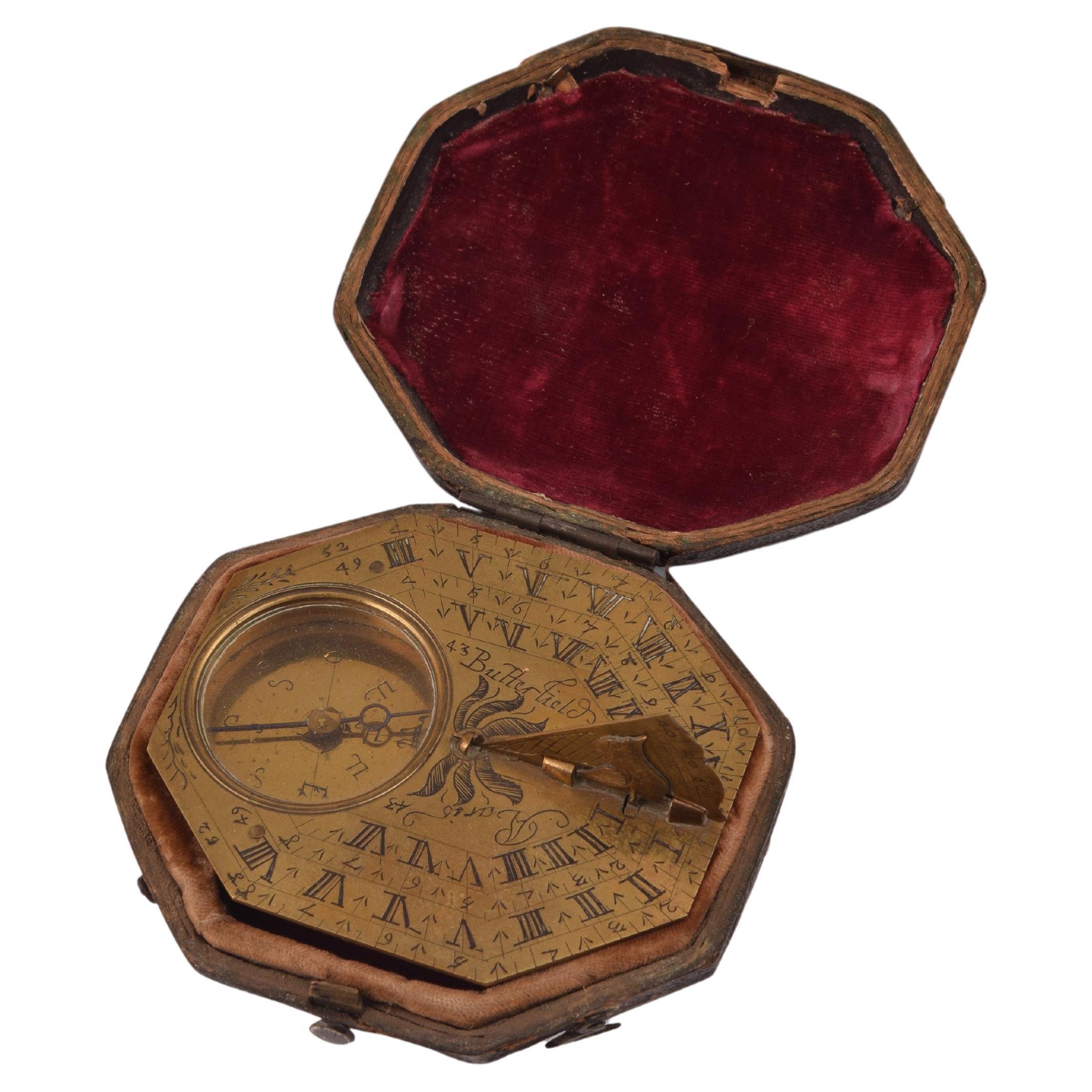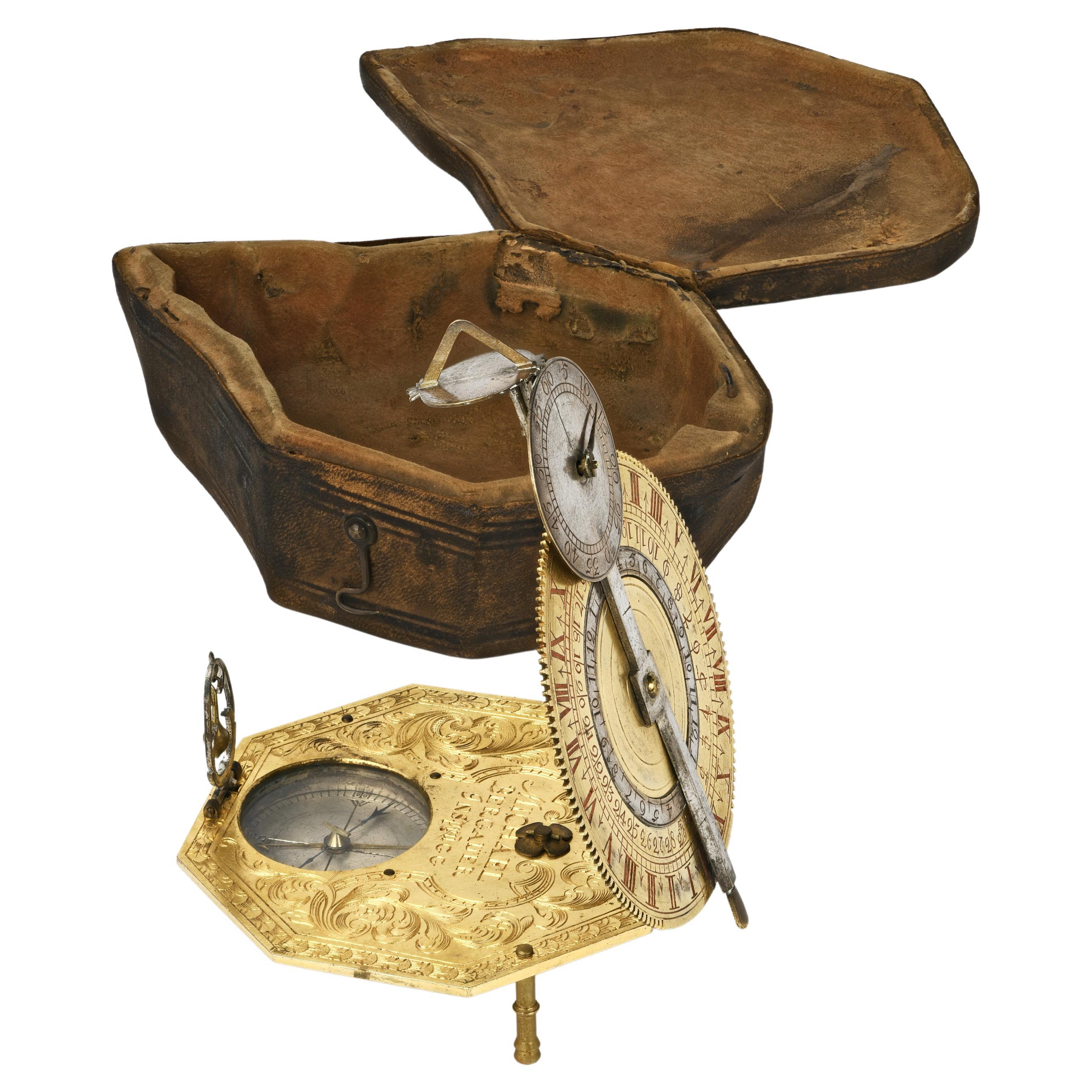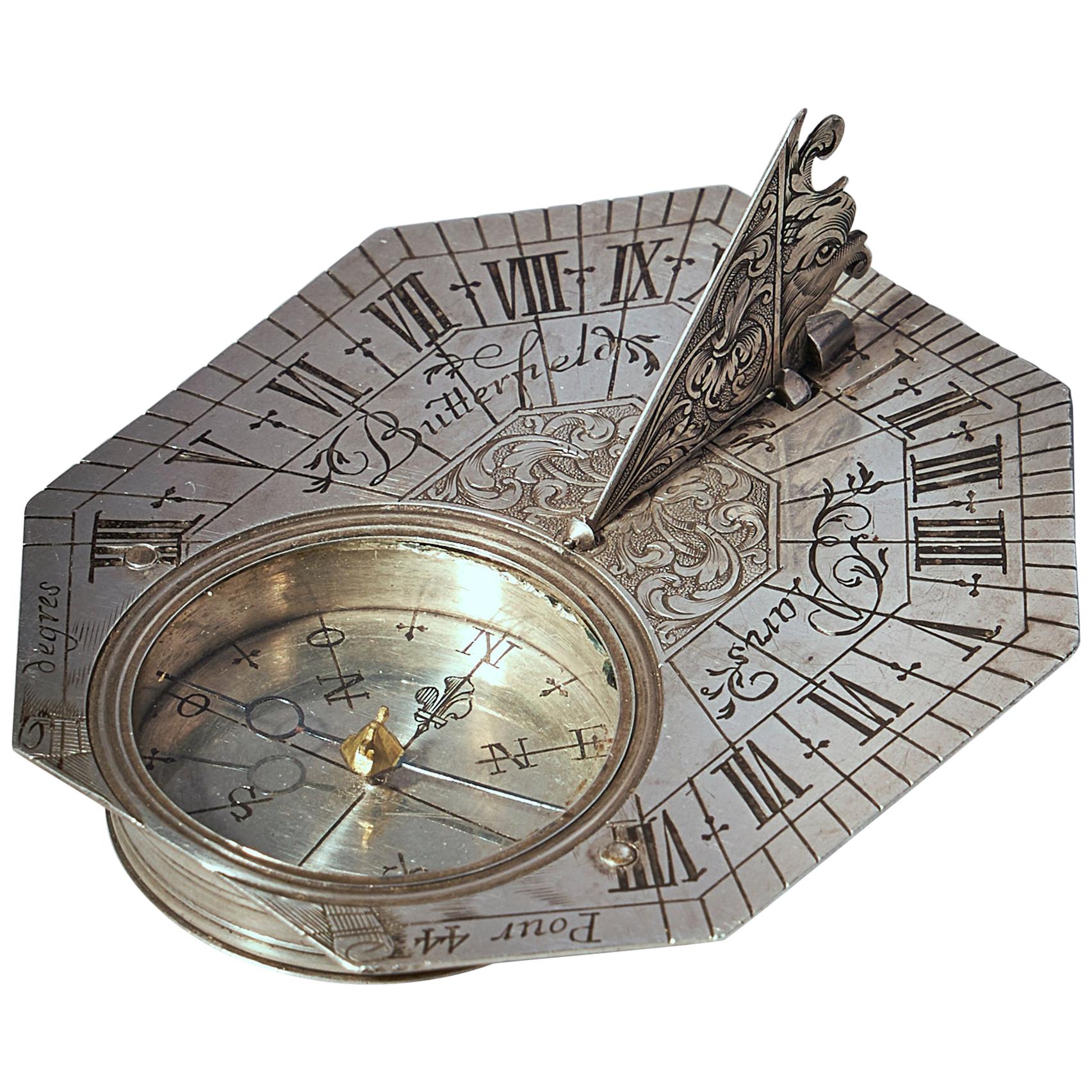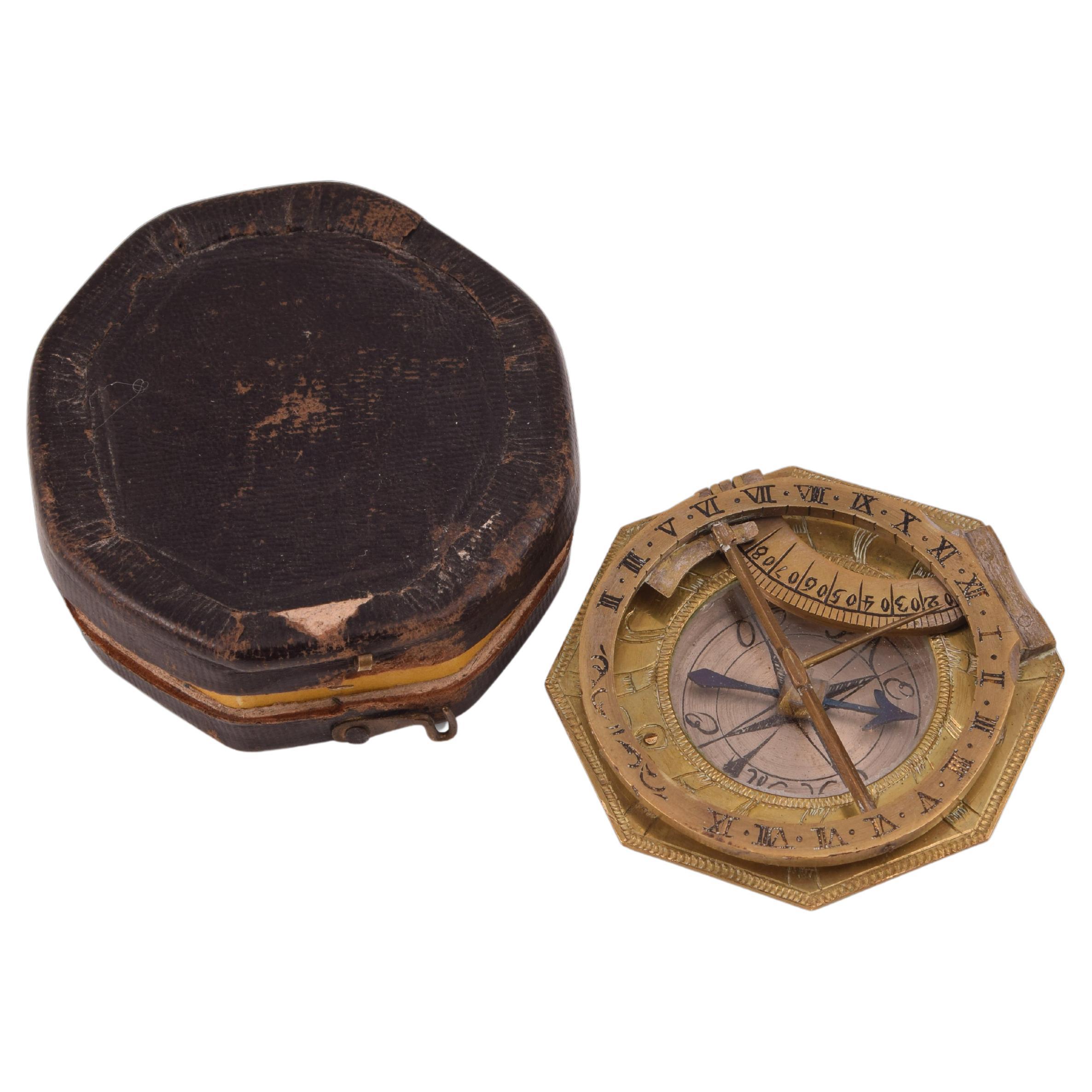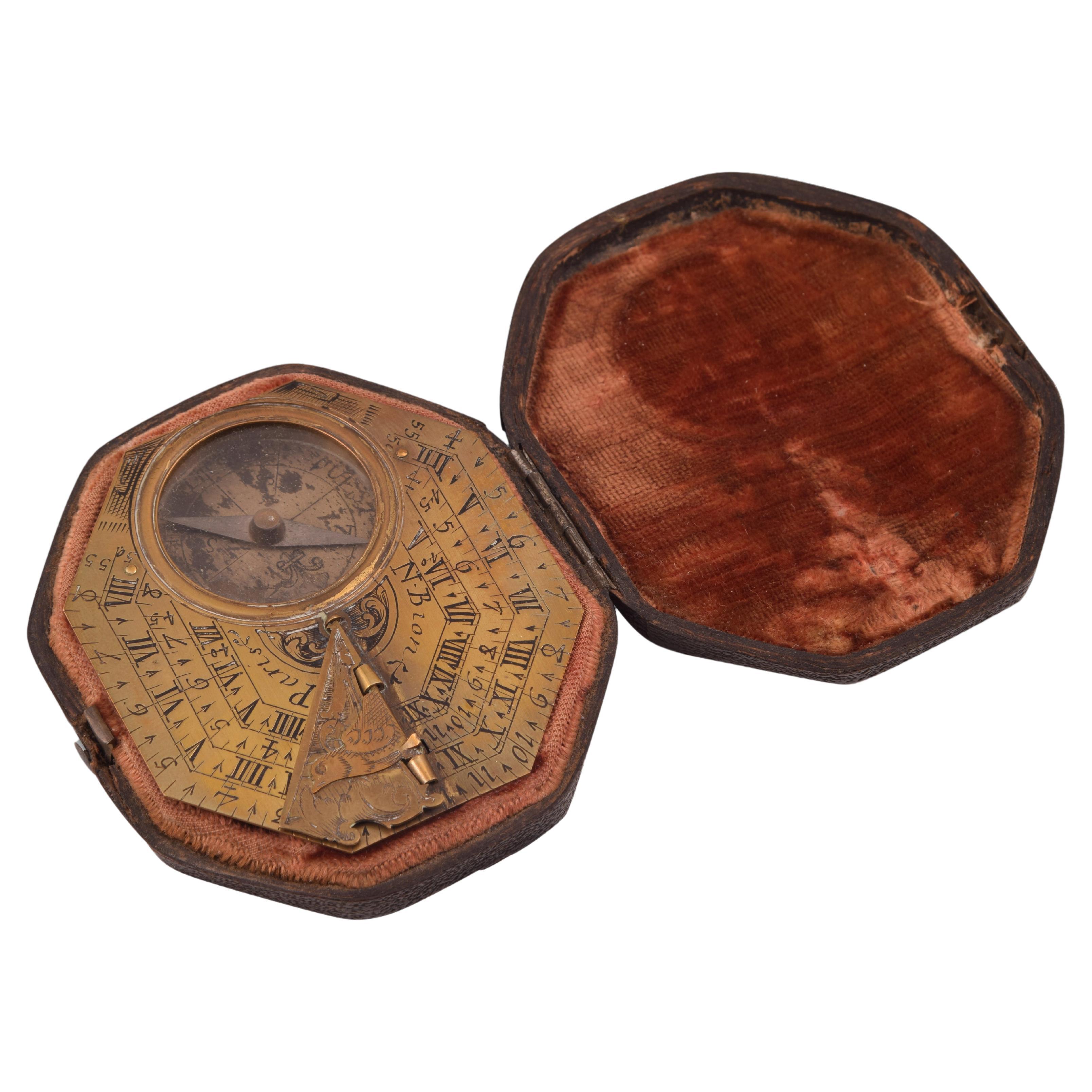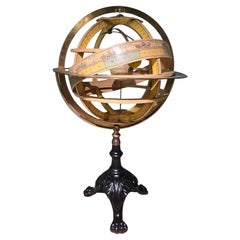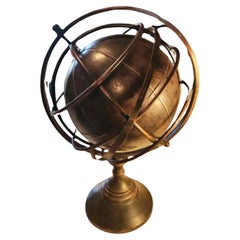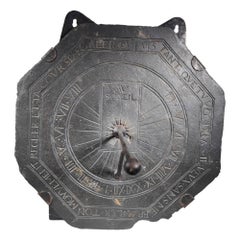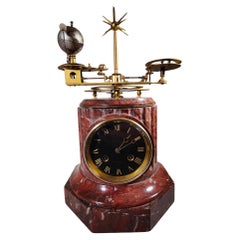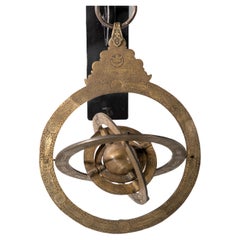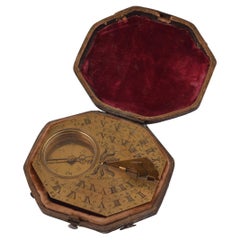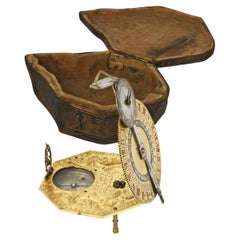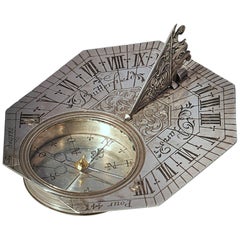Items Similar to Planispheric Astrolabe – Equinoctial Dial, late 16th–early 17th century
Want more images or videos?
Request additional images or videos from the seller
1 of 21
Planispheric Astrolabe – Equinoctial Dial, late 16th–early 17th century
$84,228.75
£63,556.15
€70,960
CA$117,395.68
A$127,613.05
CHF 66,880.49
MX$1,553,159.52
NOK 841,865.55
SEK 791,079.66
DKK 540,528.34
About the Item
Origin: Probably Southern Germany (Nuremberg or Augsburg) or the Flemish region (Louvain or Antwerp).
Date: circa 1580–1620
Material: finely engraved brass
Diameter: 9 cm
A beautifully crafted planispheric astrolabe or equinoctial sundial, dating from the scientific Renaissance. The instrument features a rotating rete and latitude circles engraved with major European cities, allowing adjustment for various locations.
Principal Latin inscription:
“Ni certa solis lumina de vient”
(“Even the rays of the sun are uncertain [or inconstant].”)
A philosophical reflection on time and change, typical of German Renaissance scientific instruments with moral inscriptions.
Cities and latitudes engraved:
Londini (London) – 52°30′
Colonia (Cologne) – 50°
Aquisgrani (Aachen) – 50°
Parisiis (Paris) – 48°
Vienna – 48°22′
Ulysipona (Lisbon) – 38°40′
Matriti (Madrid) – 40°14′
Romae (Rome) – 41°51′
Pragae (Prague) – 50°4′
This remarkable instrument likely originates from a germano-flemish workshop, most probably Augsburg or Nuremberg, two renowned centers for precision instrument-making in the late Renaissance. Its delicate engraving, philosophical motto, and geographic precision exemplify the humanist fusion of science, art, and moral thought.
A rare and museum-worthy piece for collectors of early scientific instruments.
- Dimensions:Height: 3.94 in (10 cm)Diameter: 3.55 in (9 cm)
- Materials and Techniques:
- Period:
- Date of Manufacture:1580
- Condition:
- Seller Location:Madrid, ES
About the Seller
4.8
Platinum Seller
Premium sellers with a 4.7+ rating and 24-hour response times
Established in 2005
1stDibs seller since 2021
384 sales on 1stDibs
Typical response time: 1 hour
- ShippingRetrieving quote...Shipping from: Madrid, Spain
- Return Policy
Authenticity Guarantee
In the unlikely event there’s an issue with an item’s authenticity, contact us within 1 year for a full refund. DetailsMoney-Back Guarantee
If your item is not as described, is damaged in transit, or does not arrive, contact us within 7 days for a full refund. Details24-Hour Cancellation
You have a 24-hour grace period in which to reconsider your purchase, with no questions asked.Vetted Professional Sellers
Our world-class sellers must adhere to strict standards for service and quality, maintaining the integrity of our listings.Price-Match Guarantee
If you find that a seller listed the same item for a lower price elsewhere, we’ll match it.Trusted Global Delivery
Our best-in-class carrier network provides specialized shipping options worldwide, including custom delivery.More From This Seller
View AllRare 19th-Century Armillary Sphere by Faustino Paluzie — Barcelona, circa 1880
Located in Madrid, ES
Exceptional and very rare armillary sphere made in Barcelona around 1880 by Faustino Paluzie, one of the most important Spanish makers of scientific and didactic instruments of the 1...
Category
Antique Mid-19th Century Scientific Instruments
Materials
Metal
Rare English Nautical Globe with Armillary Sphere (1930) 20th Century
Located in Madrid, ES
Rare English Nautical Globe with Armillary Sphere (1930) 20th Century
Good condition
magnificent globe, with a leather-covered wooden interior terrest...
Category
Early 20th Century English Modern Nautical Objects
Materials
Metal
Large 17th Century French Slate Octagonal Sundial
Located in Madrid, ES
A Large 17th century French Slate Octagonal Sundial
With wrought iron gnomon and profusely engraved with latin letters.Size:39x39 cm.With latter hanging ...
Category
Antique Mid-17th Century Scientific Instruments
Materials
Slate
French Planetary Clock InGided Brass And Marble Planetarium Tellurium
Located in Madrid, ES
French Planetary Clock In Golden Brass And Tellurium Marble, Planetarium
Rare French planetary from the 19th century in brass and Royal Red marble base...
Category
Antique Late 19th Century Scientific Instruments
Materials
Marble
Antique Orrery – Tellurium by Paravia, Torino (1900, Italy)
Located in Madrid, ES
Rare and collectible orrery (tellurium) produced by the renowned Italian maker Paravia, Torino in 1900. This finely crafted planetary model illustrates the Earth-Sun-Moon system, dem...
Category
Early 20th Century Scientific Instruments
Materials
Paper
Pocket Watch In 18 Carat Gold, Dating From Around 1900 with calendar
Located in Madrid, ES
Discover a piece of timeless elegance with our exquisite 18K gold pocket watch from circa 1900! ⌚️
Crafted with meticulous attention to detail, this elegant timepiece boasts a classic enamel dial on one side for traditional timekeeping and a monthly and weekly calendar...
Category
Antique 1890s Scientific Instruments
Materials
Gold
You May Also Like
Pair of Astrolabes
Located in Dallas, TX
Pair of antique brass astrolabes with iron brackets
Category
Antique 19th Century Scientific Instruments
Materials
Brass, Bronze
$3,850 / set
Compass with Pocket Sundial, with Case, Bronze, Butterfield, Michael '1635-1724'
Located in Madrid, ES
Compass with pocket sundial, with case. Bronze. BUTTERFIELD, Michael (1635-1724). Paris, circa 1700.
Pocket sundial made of engraved metal, with a gno...
Category
Antique Early 18th Century French Neoclassical Scientific Instruments
Materials
Metal, Bronze, Other
Mechanical Equatorial Sundial, Johann Michael Bergauer, Ante 1745
By Johann Michael Bergauer
Located in Milano, IT
Johann Michael Bergauer (Simonsfeld, 1676 - Innsbruck, 1745 circa)
Mechanical equatorial sundial
Signed: Michael Bergauer Insprugg? Innsbruck?
Ante 1745
Gilded and silvered brass; glass.
Measures: closed 1.29 x 3.50 x 4.92 in (33 x 89 x 125 mm); open 5.19 x 3.50 x 3.81 in (132 x 89 x 97 mm).
Weight: the sundial 0.49 lb (224 g); the case 0, 20 lb (95 g)
Original wooden case covered in brown leather.
State of conservation: very good. It has some signs of use. The spring that allowed for the two parts of the instrument to remain open is missing (absent even in the comparative specimens kept in museums).
The sundial is composed of two overlapping plates hinged together on the north edge.
The base plate is octagonal and is supported by three turned legs. The upper face is gilded and a compass with a magnetic variation index has been inserted. The rest of the surface is occupied by a rich decoration of engraved scrolls, centered around the inscription “Michael Bergauer Insprugg”. A foldable oval support with a plumb-bob is attached with a hinge on the southern edge. On the reverse of the base plate a table of the latitudes of some European cities (expanded with the vertical writing “Meiland 40” on the edge and “Rome” deleted) and of Jerusalem has been engraved. A Cam marked for 0 °-70 ° is applied near the northern edge. This can be adjusted to change the inclination of the upper plate according to the latitude; originally a spring, now lost, made it possible to keep the two plates of the clock open.
The second plate is round, has a toothed edge and measures 3.26 in (83 mm) in diameter: it is slightly smaller than the octagonal base which it rests upon and overlaps when the instrument is closed.
The recto is gilded and there are three concentric graduated circles engraved on it:
- the outermost is the equatorial hour dial, numbered I-XII, I-XII;
- the second-one is that of days 1-30 of the lunar month and has “Aetas lunae” engraved on it;
- the third, silvered, is a subsidiary hour dial, with double numbering 1-12; originally it could have been rotated.
The engravings of the first two circles are enameled in red.
In the center - on the polar axis - there is an alidade, at the end of which is associated the silvered minute dial. This, in turn, is welded, perpendicularly, to a small disc, also silvered, with a triangular gnomon. The plate, alidade and minute dial are connected to each other by toothed mechanisms.
Below is the procedure for measuring the time:
1) Adjust the Cam under the base of the clock, based on the latitude of your location;
2) Place the watch on a flat surface using the plumb-bob and with the side closest to the compass facing south;
3) Keeping the instrument still, manually rotate the alidade until the shadow cast by the triangular gnomon on the small silvered disc falls on the line marked below it;
4) The hour and minutes can therefore be read on the hour and minute dials set on the alidade respectively.
Johann Michael Bergauer, who sometimes only signs his works as Michael Bergauer, was born in Simonsfeld, north of Vienna. His apprenticeship as a watchmaker took place in Landshut and he probably worked as a laborer in Augsburg before becoming a watchmaker at the court of Karl Philipp von der Pfalz in Innsbruck in 1708. In the following years, his repeated attempts to obtain Innsbruck citizenship are documented and, in 1721, he is listed as a resident. In 1724 he was admitted to the guild of watchmakers, with which however he had continuous problems. In 1732 he presented a "masterpiece". This is the last reference to his business; he must have died before or in 1745 because in that year his widow appealed to the City Council.
The mechanical sundial...
Category
Antique 1730s Austrian Baroque Scientific Instruments
Materials
Brass
Rare Silver Pocket Sundial and Compass by Michael Butterfield, Paris, circa 1700
By Butterfield Paris
Located in Oxfordshire, United Kingdom
A beautiful, rare solid silver Anglo-French octagonal pocket sundial with compass by Michael Butterfield, circa 1700.
The sundial is made for a latitude of 44° and could be used in places in the south of France such as Avignon and elsewhere along this parallel. The elaborately engraved base plate has a Roman chapter ring on which the gnomon (a triangular flap) casts its shadow. It is signed by the maker in the following manner: Butterfield A Paris. On one side is a glazed recessed compass with a blued steel hand to position the instrument in such a way that the time can be read. The hinged triangular gnomon is richly engraved and in the shape of a bird’s head. The folding gnomon and cut corners enable the dial to be carried in the pocket.
The underside shows the latitudes of various Southern-French places in the relevant areas
Its maker Michael Butterfield was an English instrument maker who based himself in 'Le Quay de l'Horloge' of Paris from circa 1685. These types of dials, often replicated by other makers, became known as Butterfield Dials...
Category
Antique Late 17th Century French Louis XIV Carriage Clocks and Travel Cl...
Materials
Silver
Sundial and Compass with Case, Schrettegger, Johan, Augsburg, Germany, Ca 1800
Located in Madrid, ES
Sundial and compass with case. Bronze. SCHRETTEGGER, Johan. Augsburg, Germany, around 1800.
Sundial with a polygonal shape made of bronze, engraved with plant elements on the front,...
Category
Antique Late 18th Century German Neoclassical Scientific Instruments
Materials
Bronze, Other
Sundial with Compass and Case, Bronze, Bion, Nicholas, Paris, 18th Century
By Nicholas Bion
Located in Madrid, ES
Sundial with compass and case. Bronze. BION, Nicholas. Paris, 18th century.
Polygonal sundial with a bird-shaped gnomon and engraved triangular piece, which presents, on one side, ...
Category
Antique 18th Century French Neoclassical Scientific Instruments
Materials
Bronze, Other
